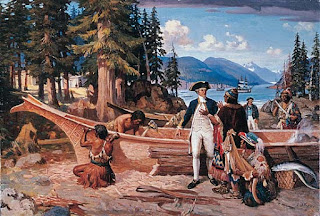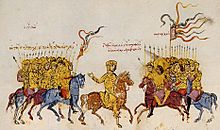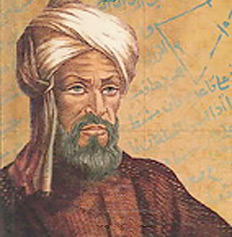As Arthur Dobbs had predicted when trying to dismantle the company's monopoly in the 1740's, only commercial pressures would prompt the Hudson's Bay Company to broaden their horizons. When they were eventually threatened by the emergence of Montreal based fur traders, who would later coalesce into bitter rivals the Northwest Company, the company attempted to diversify their interests. They began by sending out overland expeditions in the company of native guides in search of copper deposits, whose presence had been indicated by a Dene Indian leader named Matonabbee.
The mouth of the Coppermine River by George Back
In 1771 a former naval officer named Samuel Hearne, in company with Matonabbee, successfully descended the Coppermine River by canoe to reach the Arctic shore.
Hearne did not actually sight open sea but from the quantities of whale bone and seal skins he observed in the possession of the local Inuit it was clear that such existed. It was also clear from his journey that no navigable inland passage existed that could be accessed from the eastern or western coast. Hearne found no copper reserves worth the trouble and his journey is best known for his eye-witness account of the 'Massacre at Bloody Falls' of around twenty Inuit; men, women and children, by the Dene Indians accompanying him. The expedition set a template for future overland operations; following the rivers northward to the coast, living off the land and relying on the Indians' knowledge of the movements of game animals and hunting skills to keep the expedition supplied. Hearne had covered some five thousand miles and become the first European to reach the Arctic Ocean overland but in the view of the company there was little to be gained from any further expeditions.
The Northwest Passage
In 1775 the British government stepped in, offering a prize of twenty thousand pounds to any ship that could navigate the northwest passage. Of course, if there was such a thing as a northwest passage, then it had to be accessible from the Pacific as well as from the Atlantic. With this possibility in mind, the admiralty dispatched a two ship expedition to the Pacific in 1776. Naturally it was headed up by Britain's greatest exploring sailor; Captain James Cook aboard HMS Resolution, in company with HMS Discovery - always a popular name - under Lieutenant Charles Clerke. Once Clerke had extricated himself from a debtors' gaol, Discovery had joined Resolution in Cape Town and the expedition had proceeded through the Pacific at a leisurely pace; too leisurely in the view of some of Cook's officers. Having squandered the first Arctic exploration season tarrying in familiar waters, Cook finally departed newly discovered Hawaii in February 1778 and headed north. Having refitted on Vancouver Island, explored the Alaskan coast and penetrated the Bering Strait, Cook was finally stopped by a wall of ice at 70 degrees north on 18th August. The battered ships returned to Hawaii for the winter where Cook fell out with the natives with fatal consequences for himself. The nation mourned and interest in the existence of the passage was dampened.
James Cook on Vancouver Island
A decade later George Vancouver, who had sailed as a midshipman under Cook, commanded HMS Discovery on a four year expedition to the Pacific northwest commencing in 1791. The Spanish had also been showing interest in the territory and the voyage was something of a flag planting exercise. Vancouver nevertheless charted and probed methodically and diligently but found little to excite believers in the existence of the passage. War with France thereafter occupied the navy for the next twenty years with little thought for such peacetime niceties as exploration.
Once Napoleon had embarked on his own one-way expedition to far-flung St Helena, the navy suddenly found itself with large numbers of ships and even larger numbers of officers lingering on half pay in need of employment. For a plucky few, such employment and opportunity for advancement was presented by a rekindling of interest in Arctic exploration. The renewed search for the northwest passage was the pet project of the Second Secretary of the Admiralty Sir John Barrow.
Barrow was a man with a burning desire to fill in the blanks on the map and dispatched men of vigour to the Arctic and the Sahara in an attempt to ensure that it was Britain that led the way in discovery. In both theatres unimaginable hardships and privations would be suffered by those Barrow entrusted with his often poorly conceived missions. For the African adventurers death from tropical disease or hostile natives was close to inevitable whilst the polar explorers faced the prospect of years trapped in the ice and land journeys of hundreds of miles surviving on pitifully inadequate rations. Barrow presided over this heroic age of British exploration with an all pervasive influence; producing innumerable publications on geographical matters and chairing committees of learned enthusiasts whilst being obstinately blind to any argument that contradicted his own, often misguided, theories. He championed the achievements of his favourites, who reaped the rewards of their fame with promotions and knighthoods, whilst being monstrously ungrateful and vicious to those who he felt had failed to achieve their sometimes unachievable objectives. Many of those Barrow sent off into the unknown did not come back at all.
Ross and Parry meet the natives - painting by John Sackheuse
In the summer of 1818 Barrow's first Arctic expedition set out for the Davis Strait, under the overall command of Commander John Ross on HMS Isabella, ably supported by Lieutenant William Parry on HMS Alexander. Their volunteer crews were largely made up of experienced whalers. The two ships ventured up Davis Strait, leaving the whaling fleet behind them and making their way north into Baffin Bay, where no European had been since the man it was named after. Here the crews encountered Inuit who had been entirely cut off, even from their own kind. The ship's interpreter John Sackheuse, a Greenland native, was able to communicate with these 'Arctic Highlanders' as Ross termed them, and found that they believed themselves to be the only people on Earth. The natives were understandably nervous of the newcomers but curious and friendly enough, although to the dismay of the Anglo Saxons, they had no concept of property; helping themselves to any iron objects they could lay their hands on. The ships explored Smith and Jones Sounds and most controversially Lancaster Sound, all three of which were declared by Ross to be bays which terminated in high mountain ranges. This would turn out to be an optical illusion caused by atmospheric refraction. Parry on the Alexander, which had been lagging behind the Isabella, had seen no such thing. On the ships' return to England, Parry refused to support Ross' decision to turn back from Lancaster Sound without exploring further when it was questioned by a disappointed Barrow. The other young officers, including Ross' own nephew James, sided with Parry. Barrow would never forgive John Ross for his timidity.
Hecla and Griper entering winter harbour by William Parry
The following summer HMS Hecla under Parry and HMS Griper under Lieutenant Matthew Liddon, which was so slow that it had to be towed most of the time, set out once more for Davis Strait, Baffin Bay and Lancaster Sound. After following the Greenland coast to the latitude of Lancaster Sound, the ships were laboriously towed and warped through the ice floes of the central pack, with their crews straining on nine foot long ice saws and hauling on hawsers all day long for three weeks to cover the eighty miles to the far side of the pack. It may not have felt like a shortcut but it was and their efforts were rewarded in August when Hecla and Griper sailed through the open water of Lancaster Sound to cheers from their assembled officers and men. The expedition's progress was triumphant. The ships explored Lancaster Sound until ice barred their way between two large islands which Parry named Devon and Somerset Islands, though the bleak, boggy terrain of the islands bore little resemblance to those English counties. Turning south, they then explored a promising passage between the northwestern coast of Baffin Island and Somerset Island which Parry named Prince Regent Inlet, turning back after 120 miles and returning to Lancaster Sound which they were now able to penetrate further. Ice conditions were exceptionally favourable and Hecla and Griper sailed on, through a body of water Parry christened Barrow Strait to ultimately reach a furthest west of 112 degrees in mid September.
Hecla and Griper overwintering on Melville Island
With the onset of winter, Hecla and Griper settled in on the newly discovered Melville Island, named in honour of the First Sea Lord. Parry had prepared meticulously for this eventuality. The upper masts were removed and the ships were roofed over with timber and canvas. A network of pipes were installed to carry hot water from the galley stove all around the ships and keep the temperature at a reasonably comfortable level. Parry had brought plentiful stores including tinned meat, concentrated lemon juice and sauerkraut to ward off scurvy and in a particularly ingenious move he sowed mustard and cress seeds in trays arranged along the top of the hot pipes and soon they were covered with green shoots. The ptarmigan which populated the island were relentlessly hunted for fresh meat until the survivors migrated south. Along with scurvy, Parry viewed boredom as the greatest enemy and kept his men busy with daily chores. The decks were scrubbed and ice was scraped from the timbers. The officers were kept busy with scientific observations. Parry had also brought along a large barrel organ which played a reasonable range of tunes and provided both entertainment and music by which the men were encouraged to stomp around the deck when the weather was too grim to permit outdoor exercise. The organ can be seen today in the excellent Polar Museum in Cambridge and it is a thing of wonder. A weekly newspaper was produced and the officers put on theatrical productions with the midshipmen playing the female roles. Parry also ran a school so that all men of the crew who wished to learn to read and write could do so. Over the course of that dark winter, with temperatures reaching minus 75 Fahrenheit, Parry lost just one man to a lung complaint. It was a magnificent piece of leadership, providing the model for future expeditions and in Parry, the first great Arctic commander, one instantly recognises the qualities of Scott and Shackleton.
William Edward Parry
In the spring Parry began exploring the island by sledge and reached its northern coast. The summer however, brought no thaw. The ships remained frozen in their icy harbour and the prospect of a second winter in the Arctic threatened until on 31st July 1820 they were finally able to break out. Parry began once more pressing westwards but made it no further than the previous year when his ships were forced back by the encroaching ice. Parry gave up on 23rd August when it became clear that the only options were to retreat or endure another winter in the ice. They did not have the supplies for the latter and so Hecla and Griper sailed for home.
Parry's achievement was lauded by Barrow and he returned to a hero's welcome but privately he confided to Barrow that he thought the chances of making the passage so far to the north were slim to none. The focus therefore shifted once more to the north of Hudson's Bay. Parry set out again in 1821, this time commanding HMS Fury, sister ship to Hecla, which was commanded by the irrepressible George Lyon. Lyon had already had an eventful time going native in the Sahara in pursuit of Barrow's other Holy Grail - the Niger River. On this voyage Lyon would enjoy going native again, embracing the Inuit way of life; sleeping in an igloo, getting himself a traditional tattoo, sampling their food, learning their skills and bedding their women, whom he found to be most accommodating.
HMS Hecla by William Parry
Making camp by George Back
The reception for Parry this time around was more muted, for the man of the hour was Lt. John Franklin, having led an expedition down the Coppermine River in emulation of Samuel Hearne with the reluctant and half-hearted assistance of the Hudson's Bay Company. Franklin's expedition, a mixture of naval officers, locally recruited trappers provided by the company known as voyageurs and Indian guides had reached the sea and proceeded eastwards along the coast for a distance of five hundred miles to a point south of Victoria Island which he named Point Turnagain. He had ventured too far and too late into the season however and the return journey overland was a nightmare of starvation with supplies exhausted and no game to be had, surviving on moss scraped from rocks. Abandoned by their Indian guides, over half of Franklin's party were lost. Six succumbed to starvation and three voyageurs and one British officer were killed by a voyageur driven to murder and cannibalism by the extremity of their situation. The killer was executed. Staggering back to their supply hut Fort Enterprise on the Coppermine, which should have been stocked with provisions, the desperate survivors found it empty and were reduced to eating the skin from their blankets and the leather from their boots. Just in time a party led by Midshipman George Back found the Indians charged with supplying them and help arrived. It had been a pretty disastrous enterprise but the sheer endurance of Franklin had seen him lionised rather than castigated.
HMS Griper in Roe's Welcome Sound 1824
Beechey's 1825 portrait of John Adams, the last Bounty mutineer
























